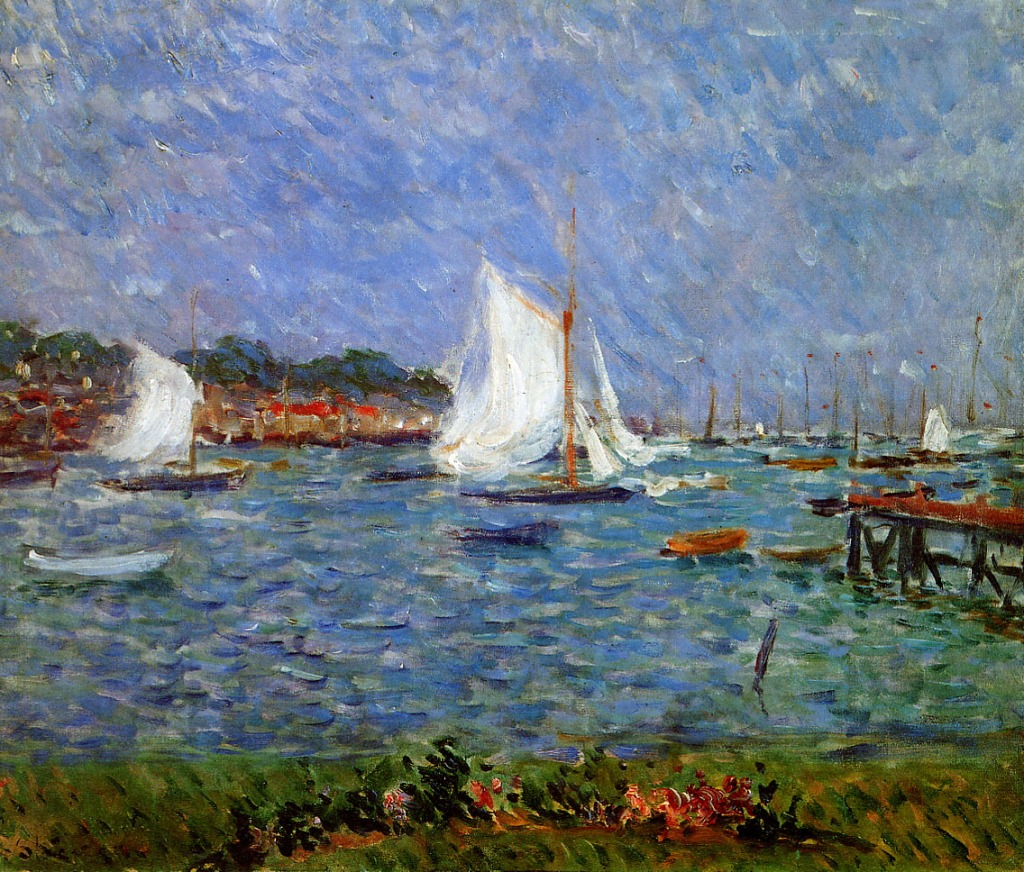Compared with most other European countries, Impressionism largely passed British painters by.
This is surprising given the popularity and influence of John Constable and JWM Turner earlier in the nineteenth century, and the presence of two American painters of great distinction and popularity in London: John Singer Sargent (in London 1886-1925) and James Abbott McNeill Whistler (in London 1859-92). However in Britain in the middle of the nineteenth century the painters of the Pre-Raphaelite Brotherhood were dominant, and William Morris’s Arts and Crafts movement brought decorative arts to the fore after that.
There are two important topics that I need to consider here, though:
- the influence that Turner may have had as a ‘pre-impressionist’ on the French Impressionists,
- the few British painters who did go to France in the late nineteenth century and formed a small British Impressionist movement.
Joseph Mallord William Turner (1775-1851)
Born in London in 1775, Turner was educated at the Royal Academy schools from the age of 14, and enjoyed early critical success. From 1802 he toured Europe, painting views as he went. In his later years his work became increasingly radical, and his critics louder. He died in 1851.
Fuller biographical details are given in my previous article in the Favourite Paintings series.

Compared with impressionist style, Turner’s late paintings have some similarities – their focus on light and colour, and capturing an impression – but some important differences, notably that his brushwork remained very tight when painting details. These are well exemplified in the painting of Venice above, completed in the last decade of his life.
Constable and Turner could have been important in the influence over those of the French Impressionists, particularly Claude Monet, who fled to London during the Franco-Prussian War in 1870. However the evidence in Monet’s work is that his mature Impressionist style had already evolved by 1870. Below for comparison are his and Renoir’s famous paintings from la Grenouillère in 1869 (Renoir remained in France throughout the war, of course).


So whilst Turner in particular may have influenced Monet, Pissarro, and Daubigny, I do not think that the evidence supports Turner’s work having any significant role in the development of the French Impressionists.
Philip Wilson Steer (1860-1942)
He was born in 1860 in Birkenhead, Liverpool, son of a landscape and portrait painter of little distinction, and studied at Gloucester College of Art from 1878-80, and briefly at the South Kensington Drawing Schools until 1881. After failing to be admitted to the Royal Academy Schools, he went to Paris to the Académie Julian, where he first studied under Bouguereau. He then moved to the École des Beaux Arts as a pupil of Cabanel.
He returned to London in 1884, and painted beach and coastal scenes at Cowes (Isle of Wight), Walberswick (Suffolk), and Étaples (Calais, N France) in a deliberate attempt at impressionist style. During the 1880s he attended various exhibitions of French Impressionist paintings, and by 1888 was the leading impressionist in the UK. In 1886 he helped form The Society of Anglo-French Painters, which became the New English Art Club.


In 1888, Steer together with Bates, Sidney Starr, Walter Sickert and Theodore Roussel were the leading impressionist modernists in British art. The following year Steer, Paul Maitland, Thomson and James formed a breakaway group of London Impressionists, which exhibited in the Goupil Gallery at the end of that year.


He showed five works at the exhibition of Les XX in Brussels in 1889, some of which included areas using the Divisionist technique of bright dots of colour, but none was fully Divisionist. From 1893, whilst his works remained largely unsold, he started to teach painting at the Slade School of Fine Art, London, alongside Henry Tonks, and to visit locations made famous in Turner’s work, and paint there. His dominant influences were Turner and Constable.

From 1896 he undertook more portraits, in which he was obviously influenced by the Rococo. Then after 1902 he concentrated on watercolour, and returned to landscapes. In 1929 he had a major retrospective at the Tate Gallery, London. He died in 1942, and the following year was commemorated by an exhibition at The National Gallery, London.
Although largely forgotten today, Steer’s earlier paintings were strongly influenced by the Impressionists, and even ventured into bursts of Divisionism at times. However his style changed repeatedly, and neither he nor other British painters of the day showed any more sustained development of impressionist style.
Others, including Sidney Starr and Paul Maitland, are now largely obscure, and even Walter Sickert is now known more for his rough nudes than earlier experiments with impressionism.
References
JMW Turner:
The Tate Turner database with over 40,000 catalogued items
Wikipedia
WikiArt
Blayney Brown D, Concannon A and Smiles S eds (2014) The EY Exhibition: Late Turner – Painting Set Free, Tate Publishing. ISBN 978 1 84976 145 1. (Comprehensive but accessible accounts and excellent large format illustrations of many of his key works, from the exhibition.)
The EY Exhibition: Late Turner – Painting Set Free is at de Young, San Francisco, between 20 June and 20 Sep 2015. Sadly it lacks many of the better works which were included in the Tate Britain showing which ended on 25 Jan 2015, but is still not to be missed.
Mr Turner (2014), biopic directed by Mike Leigh, Movie review: Mr. Turner (2014).
Philip Wilson Steer:
Wikipedia
WikiArt
Munro J (1986) Philip Wilson STEER 1860-1942. Paintings and Watercolours, Arts Council of Great Britain. ISBN 0 7287 0484 6. (A small catalogue, long out of print, seems to be the only literature on him which is readily available on the secondhand market. Limited colour reproductions.)
Robins AG (2007) A Fragile Modernism. Whistler and his Impressionist Followers, Yale UP. ISBN 978 0 300 13545 9. (An excellent account of Whistler, Sickert, and the British Impressionist movement, with illustrations of many hard-to-find works.)

